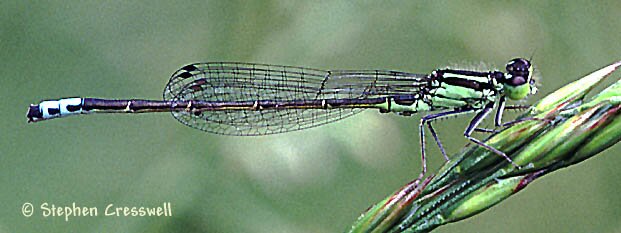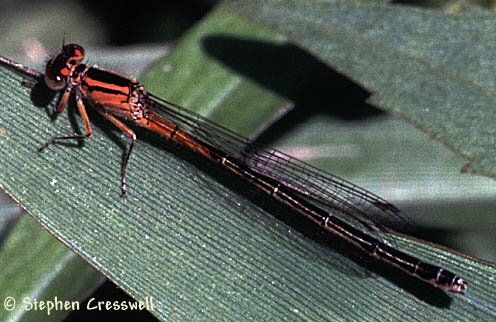

Family: Coenagrionidae
Length: 20-32 mm
This is a very common species in West Virginia, living alongside many ponds, marshes, and slow-moving streams. The species has an aversion to acidic waters, and thus may serve as an environmental indicator in the vicinity of old deep mines and strip mines.
This species has eyes dark above and green below, although in immature females the eyes are dark above and a lighter brown below.
For males, the markings on abdominal segments eight and nine are distinctive in our region. In profile, each of these two segments is predominantly blue, but with a black lateral rectangle included, as seen in the photograph at below right.
 The head and thorax of males are marked with green and black. Immature females have similar patterns on the head and thorax, but in orange and black.
The head and thorax of males are marked with green and black. Immature females have similar patterns on the head and thorax, but in orange and black.
The head and thorax of males are marked with green and black. Immature females have similar patterns on the head and thorax, but in orange and black.
O.M. Fincke (1987) captured individuals at a small lake in Michigan and wrote numbers on their wings with a felt-tip marker. After intensive observations over three summers, Fincke reported first of all that males reached sexual maturity and their mature coloration 24-48 hours after the final molt. Females took longer, about 4-5 days.
Fincke found a most unusual set of mating behaviors for an Odonate species. "Males were notably unagressive." For example, they did not drive off other males, nor attempt to separate mating pairs. If a female was sexually unreceptive she would do a wing-flutter display from a perch and a male would lose interest. If the female did not wing-flutter then mating followed, lasting about 40-45 minutes. Females oviposited alone.
Based on his field observations, and observations in an outdoor insectary, Fincke stated that most females mated only once in their lifetime. For example, in the insectary, "none of the 23 females that copulated once did so a second time." Since females oviposit alone, they are unlike other species where females in effect trade the right to mate for guarding services during ovipositing. Since mature females are known to eat other Ischnura verticalis, males are not so likely to press their attentions on uninterested females.

|
|
|

|
|
|

|
| Male Eastern Forktail, above. The eyespots are pale green, small to medium sized, and somewhat round in shape. Note that the eyespots of immature females are similar, but orange, and there is a thin orange line connecting the posterior side of the eyespots. |

|
|
|
 |
|
|

|


